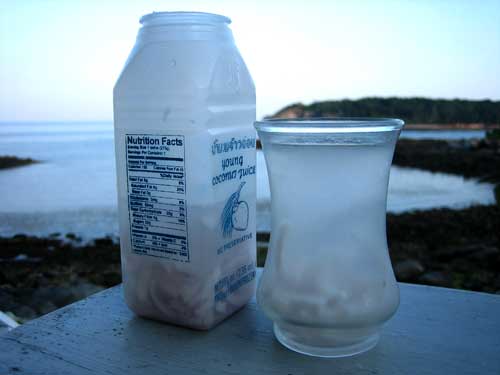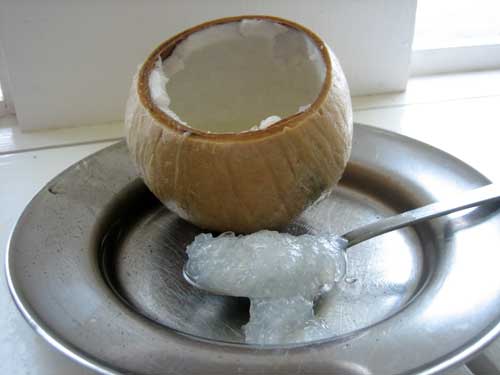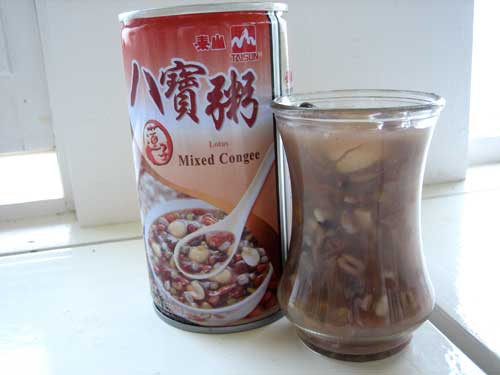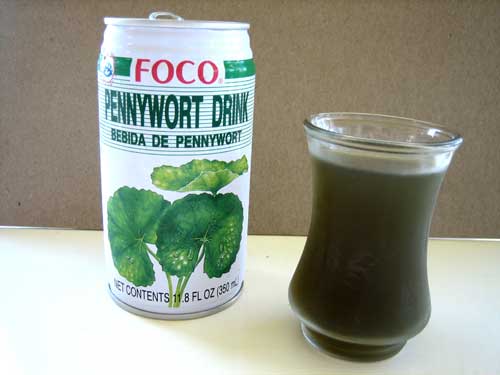From the Bollard.com
September 5, 2007
Off the Eatin' Path
By Zachary Barowitz
 |
Young coconut juice by the bay. (photos/Zachary Barowitz) |
Asian Drinks
Mouthfeel. Asian drinks score high points for mouthfeel. Soda pop has a lot of mouthfeel, but what Asian drinks have is texture – chewy, slithery texture. If you feel like texture is missing from your soft drink, read on.
Perhaps the oldest textured drink is coconut water. Mitpheap Asian Market (61 Washington Ave., Portland) sells fresh coconut water frozen in plastic bottles. As confusing as the concept of "fresh/frozen" may be, the fresh taste and long strips of sweet, tender coconut meat do not have the characteristics of a packaged product.
Those with exotic tastes and fat wallets might gravitate to the whole, frozen coconut filled with coconut jelly (gelatinous flesh of un-mature coconut; $2.59 at Mitpheap). But while the frozen drink has general appeal, the bland, almost salty flavor is only for aficionados. There are also several varieties of canned, old-school coconut water which include coconut flesh, coconut jelly, or roasted coconut. All of these are fine, if a bit too sweet, but coconut water in general is banal compared to newer products.
 |
 |
 |
 |
 |
 |
A few years ago, there was great hope for the Philippine economy – the small farmers of that country, in particular – that the production and export (mainly to Japan) of nata de coco could be its salvation. Nata de coco is a clear, flavorless, but toothsome gelatin made from processed coconuts. It can be manufactured in a well-organized home kitchen. Ultimately, bubble tea and other products pushed nata de coco to the fringes of the Japanese market, but the chunks still find their way into softer gelatins (where they play a role similar to fruit chunks), soft drinks, and jars of syrupy products (like cling peaches).
Kato brand nata de coco drinks (also available at Mitpheap) are filled with the small, chewy balls in a bright, crisp, 25-percent juice solution. Our tasters, which included a core group of nine-year-olds, praised the lemon-apple flavor in particular for its distinct taste, attractive pastel colors, good sweet-balance and granular refreshment. What's more, these products are Halal (permissible to consume according to Islamic law), and the parent company's Web site shows a very clean, modern factory in Thailand (see taveephol.com/html/factory.html).
In Australia, dads smear aloe vera juice on their children's fingers because the bitterness discourages nail-biting. Of the aloe vera drinks, buy the bottled variety from Hong Kong Market (947 Congress St., Portland) over the FOCO-brand canned products.
Basil seed drink, made with the soaked seeds of a variety of Asian basil, tastes similar to aloe vera drink, but the gelatinous basil seeds have a small, dark core. It is difficult to chew the seeds – they're elusive in much the same way as it's difficult to pick shell shards out of a bowl of cracked eggs.
Grass jelly can be purchased as a drink or as a can of jelly. I would like to say this tastes like the smell of uncut grass, but it doesn't. On the other hand, it doesn't taste like juiced lawn clippings, either. Rather, the flavor is herbal, like an Asian herbal tea.
Weirder-sounding, but much tastier, were the two varieties of white fungus (Tremella fuciformis) drink. The Malaysian variety comes in a thin can (like Red Bull), has an attractive golden color, a pleasant, slightly syrupy consistency, and, if you close your eyes, a chocolate flavor. The fungus pieces themselves don't have much flavor, but do have a jelly-like texture, and look and taste like the white, agar-rich seaweed that resembles the curly parsley some old-timers use to make pudding. There is also a Taiwanese variety that comes in a smaller can, with a folding spoon attached to the lid. This is prepared as luk mei, a traditional dessert soup with dried longan fruit (which are similar to lychees, if that helps any).
Dessert soups seem to be a thing in Asia. The milk peanut soup (Taisun brand, from China's coastal Fujian province) is sweet and good and will probably appeal to people who enjoy milk with their Jif. On the other side of the spectrum, in the extreme-texture category, is congee. Identified as gruel on some Chinatown menus, it is usually a thick soup of rice with bits of meat or seafood. Taisun's mixed congee is a cold, thick, sweet stew of rice, beans, lotus seeds, peanuts, lentils and black rice. Cold, runny, lumpy pumpkin pie or tapioca pudding might be approximate comparisons.
Thai red tea (available at Hong Kong Market) with sweet milk is hearty, distinctive, and as satisfying as a bottle of Oakhurst chocolate milk. Less exciting is commercially packaged bubble tea (tea drinks with dark or colored tapioca balls). Sun Oriental Market (622 Congress St., Portland) sells several varieties of lactic-acid-culture-treated, milk-flavored, Calpico-brand drinks from Japan. All are recommended, particularly the mango flavor. The Mong Lee Shang-brand soy-milk variety (product of Taiwan) is unremarkable. Better to make your own by boiling the balls for five minutes and adding them to tea sweetened with honey and either evaporated milk or fruit juice. The balls are also available at Hong Kong Market.
A second category of Asian drinks consists of those derived from fruits, vegetables, or herbs. Sure, they are made from weird ingredients, but our soft drinks are flavored with all sorts of roots, leaves, beans, and nuts (like burdock, ginger, and birch). Heck, the official soft drink of Maine is flavored with gentian, which, when taken in a homeopathic dose, is supposed to treat discouragement after a setback (doesn't seem to be working). Red Bull and other energy drinks containing taurine (an organic acid in bile) are copies of the Thai drinks available at Mitpheap Market that look and taste like Red Bull minus the carbonation.
Most tasters found these drinks to be "bland," "flavorless," "watery," or just plain gross. In most cases, the kids are dead wrong. The drinks are subtle, delicate and refreshing, particularly on a hot day. Sugar-cane juice has the raw flavor of unrefined sugar (before the molasses is extracted); winter melon (a variety of squash) is flavored with caramel (tastes sorta like liquid zucchini bread). Of the two brands of Taiwanese-manufactured, bottled, passion-fruit green tea I found at Hong Kong Market, the E-Ben (sic?) brand was better for being a little less sweet, but it is hard to go wrong with passion fruit.
The Unique Packaging Award goes to the carbonated melon soft drink with the Japanese characters on the label available at Sun Market. This drink comes in a glass bottle sealed with a glass ball that gets pushed into the bottle by a special drive attached to the top. The presentation is great, but the practice is poor – the hole is too small to drink out of, so the liquid either needs to be poured or suckled; the contents are less exciting still.
There are some down notes. Hawthorn Berry Drink is flavored with plum, hibiscus and licorice, but it tastes like meat marinade due to a distinct hint of smoke.
Then there is the pennywort. As one taster put it: "It looks like the leftover liquid in a bag of rotten spinach." Another simply said, "swamp water." Made from the leaves of the Asian pennywort plant, the drink is green, murky, and overly sweet. I suspect the flavor just takes some getting-used-to (after all, Americans have embraced sweetened carrot juice).
The good news about pennywort (Centella asiatica), which is also sold under the name Gotu Kola, is that it's thought to have numerous health benefits, including opium detox. As such, pennywort can be thought of as an anti-junk food. Perhaps with a name change and a little re-branding, the Taiwanese company FOCO will have the next Red Bull.
Pennywort and opium-infused vodka anyone?